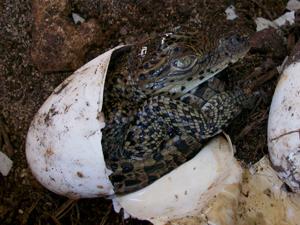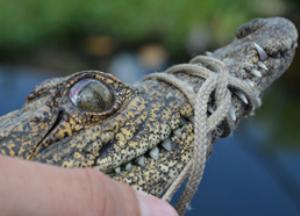Yoamel Milián-García
Other projects
16 May 2014
Genetic Characterization of the Critically Endangered Cuban Crocodile (Crocodylus rhombifer) and its Congener C Acutus in Cuba: A Conservationist Outlook II
31 Mar 2016
Conservation Genetics and Molecular Systematics of Cuban Crocodylus (Crocodylia: Crocodylidae)
To gather genetic information to assist in the evaluation of the current conservation status of the two species of the genus Crocodylus in Cuba, and to determine the frequency, direction and timeframe of hybridization.

Offspring of the Cuban crocodile.
In Cuba exists two of the four species of the genus Crocodylus that belong to the New World; one of them being endemic and critically endangered. The critically endangered Cuban crocodile (Crocodylus rhombifer) has the smallest geographic distribution of all New World crocodilians, occurring only in two regions of the Cuban archipelago: the Zapata and Lanier Swamps. This Cuban endemic species coexists with the American crocodile (Crocodylus acutus). It has been shown that both species hybridize in the wild and in captivity. The reasons for this hybridization and its conservation consequences are poorly understood. However, given the fact that the American crocodile is widespread and abundant, and the Cuban crocodile has a very limited geographic range, the potential for the loss of the Cuban crocodile, as a species via hybridization with American crocodiles, is a matter of great conservation concern.

Counting neonates for sample collection by Yoamel Milián-García.
Among crocodilians, hybrids may occasionally be detected based on morphology, but that detection could be unreliable given that morphological variation may also result from phenotypic plasticity. In addition, there is a gap of genetic information, as well as morphological studies, hindering the establishment of effective and long-term conservation management plans. This project intends to combine genetic and morphological data to estimate rates of hybridization between the two species.

Immobilized Cuban crocodile during a sampling trip in Zapata Swamp Picture.
Hybridization occurrence and the losing of genetic identity are considered current threats. The magnitude of them remains poorly understood, impeding to establish effective conservation management plans. The present proposal has the following goals: to gather genetic information to assist in the evaluation of the current conservation status of the two species of the genus Crocodylus in Cuba, and to determine the frequency, direction and time-frame of hybridization between the Cuban and the American crocodile.